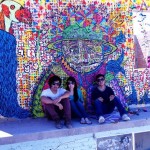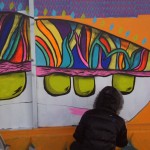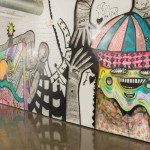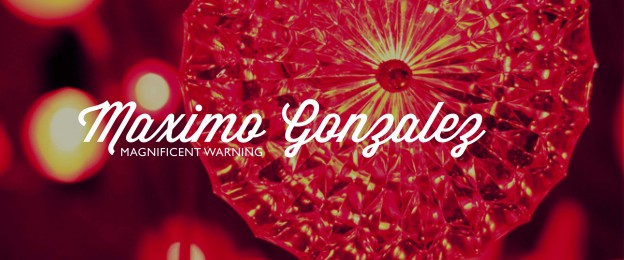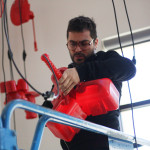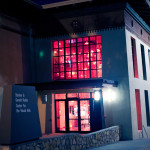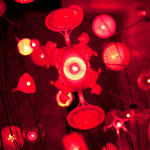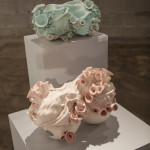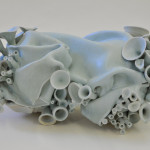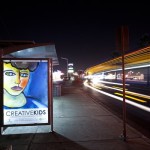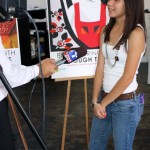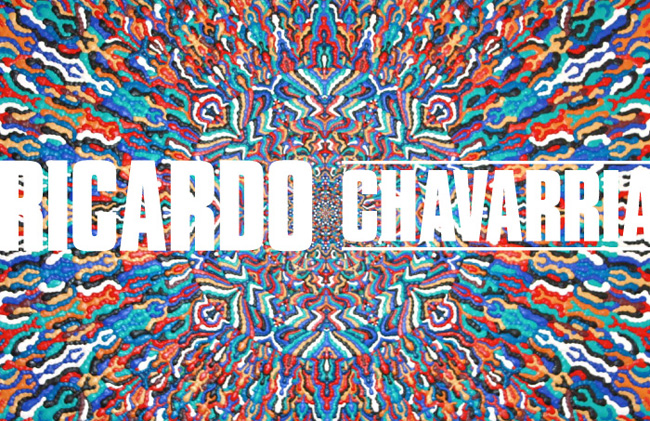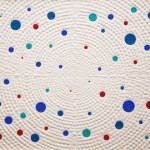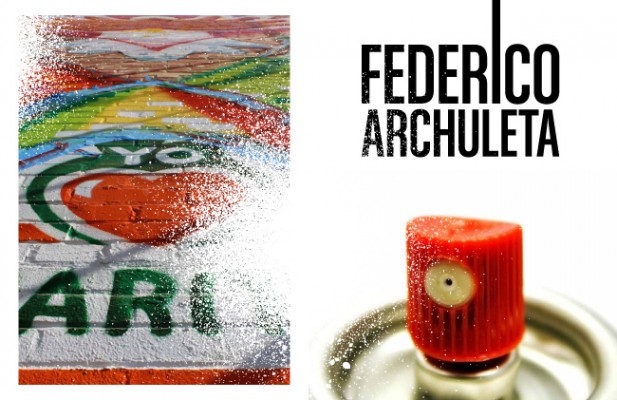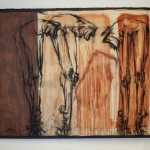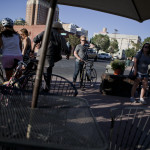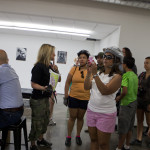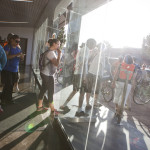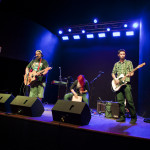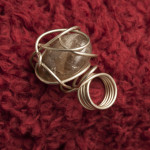Defining a Border Artist
By Peter Svarzbein
Photographer Peter Svarzbein recently had the privilege to sit down with painter Werc Alvarez for an interview on border and public art and simply being Werc. It’s not everyday one has the opportunity to speak with an artist whose art is known all over the world, and I don’t mean just the U.S. and Mexico, I mean all over!
Jari “Werc” Alvarez was born in Cd. Juárez and raised in El Paso. His love for both countries is hugely professed in the “El Paso Port-All” mural measuring 90 x 10 feet at the entry of the Stanton Street Bridge. It’s an acrylic mosaic portraying life on both sides of the border.
Peter: What makes a border artist?
Werc: A border artist is an artist who creates artwork inspired by or formulated by a dialogue created from dealing with border issues or the experience of border culture. A border artist can possibly also be defined as an artist who resides in the vicinity of two political or geographical areas, or, perhaps, an artist who creates from issues dealing with marginalization. Maybe a border artist is an artist who ascertains that he/she is a border artist.
Peter: Tell me about the inspiration behind the “El Paso Port-All”?
Werc: “El Paso Port-All” is inspired by the awe-inspiring sunsets, border culture, history, and traditions.
Peter: What do you think art’s role is in an urban/public space?
Werc: The role of art is to interact with its viewers, whether it is through inspiration, beauty, education, or subjugation by stimulating your thoughts and/or perceptions.
Peter: You were working in Europe recently. What brought you back to El Paso?
Werc: I came back for a few different reasons. One, as a getaway to dive into my work and develop artwork in a large space without a large overhead. I also want to share knowledge, stir things up in El Paso, and add to the visual landscape.
Peter: Who is your audience?
Werc: My audience is varied and diverse because my art practice is as such. I would say that it is more defined by the artwork or the project.
Peter: How did you start painting?
Werc: I started painting with spray paint on walls first, with letters, characters, and background elements. I began exploring other media around 2004. At that time I started expanding into painting on canvas/panel as well as fiberglass sculptures and digital mediums.
Peter: Why aerosol?
Werc: The spray can for me is one of the most contemporary tools today, and it is the medium I’ve been working with for 20 years. I love working with it, the effects you can create, and the challenge to wield this tool. In fact, there are only a few artists today who have mastered this medium.
Peter: What impact do you want to have upon the younger generation?
Werc: For me, it’s about adding to communities and impacting younger artist through workshops, exhibits, and sharing knowledge, creating community, and promoting creative forms of expression as a way of living.
Peter: What does the future look like here in La Frontera?
Werc: I feel the future is bright. El Paso is flourishing, and I remain hopeful and envision a Cd. Juárez free and full of life.
Peter: How do you interpret politics in your art?
Werc: Due to my multi-discplinary nature I interpret politics in different manners. In my work I often deal with the politics of identity, and issues that resonate with a multi-cultural experience which can be postulated subversively, or thru imagery/design.
Peter: How did you receive the name “Werc” if your name is Jari?
Werc: Werc is my Nom de Plume, and it was not bestowed but rather adopted. The origin of the name started as an antithesis name to friend & collaborator Isaias Crow. Our graffiti backgrounds path led us to clash & then befriend each other. Today the meaning of my name has evolved into a statement of its own to provoke dialogue about Werc/Work.
www.wercworldwide.com
Photographs courtesy of Werc Alvarez and Peter Svarzbein
Magnificent Warning
By Alejandra Saldana
A native of Argentina, Máximo González is a Mexico City-based artist well known for crafting works that involve the study of popular culture, contemporary politics, and the reutilization of materials. González uses ordinary, mundane objects that are so common and easily produced, that they almost become disposable. He uses items such as plastic fly swatters and infuses them with a handmade elegance, which spawns a fresh and unanticipated reflection on the significance of value and utility.
Among the everyday objects that González employs are non-circulating banknotes, light bulbs, and slingshots. González has an abundant portfolio of work involving the use of devalued currency, which was inspired by the Argentine Economic Crisis that took place in the late 1990s and early 2000s. In using currency that no longer had any usable value, he created intricate works that gave in a sense, gave some value back to the currency. González works in a manner that brings his obsessive personality to light by creating meticulously crafted works that are both mentally and time consuming.
In addition to creating original artwork, González promotes the work of emerging artists through an ongoing project known as Changarrito. Founded in 2004 by the artist himself, Changarrito offers alternative platforms for artists working in various media to display and sell their art. This venture occurs simultaneously at venues where Maximo is showing his own exhibits.
The installation Magnificent Warning was in production for a little over a week and involved González himself, as he directed Rubin Center student interns and student volunteers in the installation of his works. Maximo also participated hands-on in the installation, but was for the majority of the time involved in guiding the students as they installed his works—which undeniably provided the students with the experience of working in a genuine museum environment.
Maximo’s Website: http://www.maximogonzalez.info/?lang=en
Rubin Center’s Website: http://academics.utep.edu/Default.aspx?alias=academics.utep.edu/visualarts
Photographed by Alejandra Saldana
Danielle Wood
By Kimberly Rene’ Vanecek
Danielle Wood’s sculptures relate to abstraction, marine biology and ideas dealing with the subconscious. Her pieces are reflective most of abstraction, psychology, marine biology, and ideas pertaining specifically to the subconscious. “It has been said all artwork is autobiographical and I would have to agree with that statement to a certain extent. My work is definitely inspired by the subjects and aesthetics I find most interesting and beautiful,” noted Wood.
German artists Ernst Haeckel and Karl Blossfeldt influence Wood’s artistic work. Haeckel was a biologist, but also an artist who created beautiful, intricate drawings of Radiolarian, which is a microscopic organism found in ocean water. Blossfeldt was a photographer that made photogravures of thistles, moss, and other organic forms magnified.
Her wall composition is individually hung with 1,540 individual pieces on the potter’s wheel for this installation piece, symbolizing the letters of the alphabet. “I threw 26 forms forty times to equal 1,040 and threw 500 forms on the potter’s wheel over the summer. This project took me 5 months to complete and install,” stated Danielle.
The message she wants to communicate is that the ocean can be a metaphor for the subconscious due to its infinite mystery and that the ocean is a space to protect due to its immense beauty and biodiversity.
When asked whether she felt art was a therapeutic element, she responded, “I have been told art should not be therapy, and I understand it is important to have a basis for what one’s work is about. I also believe that one should enjoy the process of art making and
I think it is close to impossible to not find some sort of emotional reward for working in the arts.”
By using clay, she felt it was a material that completely involves the participant. Unlike, drawing where the artist is making a mark, with clay, she says, you are in the material.
Photographed by Peter Svarzbein
Creative Kids
By Kimberly Rene’ Vanecek
It’s not the conventional way to display art, but it’s all about using open spaces, right? So the next time you drive by a Sun Metro bus stop, don’t be surprised to see some colorful and original artwork displayed at the shelters. What you might be surprised to learn is that the artwork was designed by a group of kids!
The group of young artists who participated in the Creative Kids art program at oLo Gallery this summer produced over 35 pieces of artwork that are currently showcased at Sun Metro shelters throughout the city. The kids who participated in the project ranged in age from 9 years old and upwards.
The project was the second year for an artistic collaboration with Sun Metro and Creative Kids at oLo Gallery. “The Creative Kids art doesn’t just allow the community to benefit from the beauty of the artwork, but the kids have an opportunity to showcase their artistic expressions for the entire community to view,” noted Sun Metro Director, Jay Banasiak.
Deana Castro, age 14, whose rendition of “Freda” was chosen to be exhibited at one of the Sun Metro stops, said, “I just want to thank Oscar, my teacher, and for oLo for bringing us this program.”
Creative Kids Director, Steven Ingel, is excited to be a sponsor of this program, saying, “Art education is a powerful tool, but it is just not being used enough. We are happy to provide a program the mixes graphic design and art design and have the kids create art that livens up our town.”
Deana Castro, Age 14 – Freda portrait
Wendy Reyes, Age 12 – Building shot
Brenda Hernandez, Age 12 – Migrant workers
Photographs by Kimberly Rene’ Vanecek
Innovative Design
By Kimberly Rene’ Vanecek
Paintbrushes and sponges are absent in this artist’s studio. Gone are the days of conventional painting for an artisan who works simply with dental syringes to create his works of art.
Ricardo Chavarria is surprising people with his method of painting and with the geometric figures he creates. “My improvisation takes place within the strict rules of symmetry and form. Not knowing what exactly will happen in a painting keeps the process exciting and challenging for me,” noted Chavarria.
His multi-dimensional works of art are inspired from mandelas created by Buddhist monks and Chavarria hopes that his work stimulates a pulse or a vibration for the viewer.
Chavarria’s works are in private collections throughout the United States and can be seen throughout downtown El Paso at the El Paso Museum of Art, the Sotoa Building and at Bowie Feathers. Chavarria plans on showing his collection in New York later this year.
www.themagnetar.com
Photos courtesy of The Art Avenue Magazine
Federico Archuleta
By Kimberly Rene’ Vanecek
Federico Archuleta takes graffiti art to new heights in downtown El Paso. Soft drink giant Jarritos, in conjunction with “Amor por Juarez”, convinced Archuleta to scale a massive scaffold three stories high to compose a mural on the backside of the Sotoa building. Both groups wanted to communicate a message of unity between two countries and cities.
“I have never done a project this massive! I am familiar with larges spaces, but this palette towers in at 36 feet tall. It’s quite the test to work on scaffolding this high, plus, this isn’t a flat surface. Working with bricks can be tricky,” noted Archuleta.
The height added with the elements of 50 mile per hour winds, rain, and dust created a bit of a challenge Archuleta was able to effectively manipulate.
The Sotoa building is a three-story office complex located on 500 W. Overland Street. The backside, where the mural was placed, faces not only Ciudad Juarez, but also the heavy traffic of Paisano, near the Union Depot.
“It’s in a great spot to receive the visual recognition it needs,” Archuleta noted.
Luis Fernandez, Novamex, CEO, noted that, “Having this work of art on our building is a great reinforcement of the message of Amor Por Juarez and how tied to each other El Paso and Ciudad Juarez really are. It’s important that businesses in both communities help express these types of messages and this mural does just that.”
www.graffitiwestern.com
Photographed by Kimberly Rene’ Vanecek
Gabriel Diaz
By Kimberly Rene’ Vanecek
Gabriel Diaz is an artist who paints on a grand scale. His works are stretched upon canvas and can easily absorb an entire wall. Each piece Gabriel creates, draws the viewer into his emotional realm and leaves the audience with unique interpretations from each painting.
KV: You tend to favor human objects when painting. Is this an area that you feel is your comfort zone?
GD: More than comfortable, I would have to say that working with the human body excites me in a great way; I find that it has an incredible ability to transmit presence and expression. Along with the idea that the viewer will be able to make a direct and personal connection with the human conditions displayed in the artwork.
KV: I have seen you experiment with dimensional paintings but yet you seem to gravitate towards the human body?
GD: I feel drawn and fascinated with the finesse, elegance and beauty of the female body. When I work with the male body it is because I enjoy the sheer force and power it communicates.
KV: Is there a personal story within each piece?
GD: Most definitely, all my works are like segments of my life. When I’m working it is a constant inward search for memories and feelings that stimulate the creative process. That is my fuel.
KV: You have chosen to work with darker colors, is this representative to a certain emotion, like pain?
GD: I find dark bold marks to be very stimulating; although these could easily be interpreted as pain I see them more as strong visual statements.
KV: Is it possible for an artist to paint without inserting any emotions into their work?
GD: I think it’s possible; there are many artists that are more analytical than emotional when it comes to art making. In my case it would be basically impossible due to the fact that my work is generally based on emotions.
KV: Do you ever miss your paintings, knowing your emotional connection to them?
GD: Of course I miss them, I really enjoy having dialogs with the pieces after they are done, but I guess that letting go is very important because it’s the first step toward moving on to making something new, and hopefully better.
KV: What do you think of contemporary art?
GD: There is a lot of great contemporary art out there, but the ones I have enjoyed the most have been during a visit to Mexico City when I got to spend time in front of murals by Siqueiros and Orozco, the force and incredible presence of these murals were a true life changing experience for me.
KV: Who are your influences?
GD: Edward Munch, Joel Peter Witkin, Lucian Freud, Francis Bacon, David Alfaro Siqueiros and Jose Clemente Orozco.
KV: What are your choices of mediums?
GD: Acrylic paint and charcoal, I like the immediateness and quickness these materials allow you work with.
KV: I understand you have been painting for quite a while?
GD: Since early childhood I have felt an incredible amount of joy while painting, but in 1999 I enrolled for art classes in college, that’s when things began to get more serious.
KV: Where did you study?
GD: I was fortunate enough to study art at the University of Texas at El Paso.
KV: Do you currently work in a studio?
GD: Yes, it is located in downtown Juarez, my favorite part of the city.
KV: I can’t help but notice over the course of time, I see you speak of Juarez with such a passion?
GD: I was born and raised in Juarez so I feel very attached to this city, of course I would love to travel and work in other parts of the world, but Juarez will always occupy a special place in my mind. Juarez is an incredibly visually stimulating city. It is also a scenario of great social contrasts within itself and with it’s neighboring city El Paso, Texas. There is constant change and is currently trying to renovate itself from the terrible wave of violence and fear it was struck by these past years. Personally I love walking in downtown Juarez enjoying its colors, textures, sounds, smells, etc. These walks give me great feedback. I think subconsciously I am influenced by all these elements, but when I paint, I do whatever comes naturally. Juarez’s urban gallery, this consists of 50 printed images of my work displayed in the streets of Juarez. These exhibitions are scheduled for January 2013.
KV: What mark or legacy do you wish to leave in the art world and what would you like your artwork to exude?
GD: When making art I focus on the moment, if later on the work gets recognized that is a big plus, but for me the best moment is when I am executing the piece. It gives me a great sense of satisfaction to get into a heated dialogue with the work in progress, coming to terms with it and ending up with a satisfactory execution. I love the challenge. If my work gets to leave a mark in the art world that would be an excellent feeling, if that gets to happen, I think that I would like to leave a mark of strong and forceful artwork. Made up of bold decisions, strong statements and good compositions.
KV: You showed at the Amor por Juarez art auction. All four of your pieces sold that night. That’s a great statement! Do you have plans for an upcoming show?
GD: I am currently preparing for a solo exhibition at the “CUDA” (Centro Universitario de las Artes) building in Juarez, Mexico. It will consist of grand scale paintings, drawings and suspended sculptures. Along with a simultaneous solo exhibition at the University of Cd.
Photographs by Kimberly Rene’ Vanecek
Art Crawl with The Art Avenue
One of the last events celebrating Bicycle month found over 50 cyclists participating in the “Last Thursdays”. Kaycee Doughtery, creator of the downtown art event, also known as “The Art Crawl”, organized the group in San Jacinto Plaza and toured the cyclists through the galleries, restaurants, boutiques and musical venues that host special art events on the last Thursday of every month. The crowd stopped at several locations soaking up local art and learning about great deals on shopping and food in the downtown area.
Jewelry Creations for Discerning Taste
By Aracely Lazcano
The pieces of jewelry that the students of Elza Crespo design are not only unique, but each of them holds the sparkle of its own special story. Crespo, is a communications and graphic design instructor from the Autonomous University of Ciudad Juarez (UACJ), who leads a combined effort in our sister city to teach women living in impoverished areas to transform their lives through jewelry design.
Since last October, and as part of the Amor por Juarez activities, the program “Uniting Our Families” or “Uniendo Nuestras Familias”, aims to help 1,200 women residing in 53 Colonias in the outskirts of the city.
Most of the time, the students have a rough concept of what they want to craft and it is through Crespo’s expertise that they learn to define their creative process by not only visualizing a concept, but by turning it into a reality. “I help them to develop their creativity and transform an idea into a piece of art,” she said in an exclusive interview with The Ave Avenue.
An artisan jewelry designer herself, Crespo is training over 130 volunteers to give a new meaning to what some would consider, household garbage, into breathtaking necklaces, earrings, and cuffs. Their hope is to spread through other underprivileged neighborhoods to share their skills with more women.
The program extends over a four-week period, at one three-hour course per week, it was initially funded by The Arts and Culture Institute of Chihuahua (ICHICAI). ”They bring their own material, anything that can be re-purposed is used in the class, from empty metal cans, broken pieces of wood, computer discs or paper to seeds like corn, beans, or lentils.”
One of our biggest achievements is that the participants can help themselves and their families by selling their works. Additionally, they also improve their moral and civic values by getting pride on becoming creative. “It has helped them to build their self-esteem and also explore new ideas. Some have become very imaginative and had experimented by combining their recycled material with papier-mâché,” the instructor added.
Although the program needs funding to reach its goal, for now the participants are trained to use household items instead of specialized tools. ”We teach them to work with their husband’s or neighbor’s tools because when they have a clear idea of what they want to create, anything can be of help.”
Some of the collections have been included in the Time Allegory Exhibit presented in several museums across the border, including the Chamizal History and Anthropology Museum, the National Institute of Fine Arts (INBA), and the UACJ library among others.
For now, Crespo is very pleased with the accomplishments, in particular because they are diverting the negative perception to something positive. “Ciudad Juarez is considered as a gateway city with no culture of its own. We want to show the opposite, we have a beautiful culture and hundreds of proud and creative women,” she concluded.
Photographed by Peter Svarzbein




